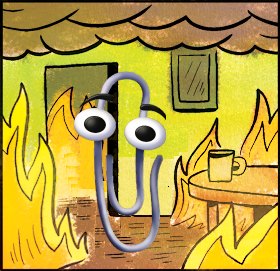How do you guys get software that is not in your distribution’s repositories?
Why not just stick to what we’ve always been doing?
- wget something.tar.gz
- tar something.tar.gz
- man tar
- tar xzf something.tar.gz
- cd something
- ls -al
- ./config.sh
- chmod +x config.sh
- ./config.sh
- make config
- Try to figure out where to get some obscure dependency, with the right version number. Discover that the last depency was hosted on the dev’s website that the dev self-hosted when it went belly up 5 years ago. Finally find the lib on some weird site with a TLD you could have sworn wasn’t even in latin characters.
- make config
- make
- Go for coffee
- make install
- SU root
- make install
I much prefer our modern package format solutions:
- sudo apt install something
- open
- wtf this is like 6 months old
- find a PPA hosted by someone claiming to have packaged the new version
- search how to install PPAs
- sudo apt <I forgot>
- install app finally
- wtf it’s 2 months old and full of bugs
- repo tells me to report to original developer
- report bugs
- mfw original dev breaks my kneecaps for reporting a bug in out of date versions packed with weird dependency constraints they can’t recreate
If you don’t compile from source, do you even Linux?
Linux From Scratch user detected
Or Slackware
Or gentoo.
I understand appimages. I use them exclusively. Can someone explain what flatpak and SNAP are and how they work? I have autism so please be as clear and concise as possible?
deleted by creator
Native package manager > Native binaries > AppImage > Flatpak.
Yes, snap isn’t even on the scale.
Not a fan of AppImages myself. For an universal format it has surprising amount of issues with different distros, in my experience. And the whole Windows style “go to a website, download the AppImage, if you want to update it, go to the web page again and download it again” is one thing I wanted to get away from. At least they don’t come with install wizards, that clicking through menus thing was a pain.
For one off stuff I run once and never need again, AppImage is alright. But not being built-in with sandboxing, repos, all that stuff, it just seems like a step back.
I ran into the same issues, mentally, when trying out AppImages for the first time - but my attitude changed once I found and started using this tool: https://github.com/ivan-hc/AM
App images are a very Windows way to do things. They bundle everything so they are big
I’m a technically savvy but new to Linux user who installed Mint as my primary OS about a month ago. So far I’ve used Flatpaks and AppImages without any issue and haven’t come across snaps. Would you explain the differences and why I would care about one over another?
IMO flatpaks are the future of installing linux apps. The comment you replied to lives in the past. System package manager should be for system binaries, not for applications.
But I like my applications years out of date and I think its good that every distro has to spend manhours on packaging it individually.
lmao you joke but half this thread is exactly that opinion
I see the appeal for the package manager for a lot of things, but space got so incredibly cheap and fast that duplication is way less of a deal than the effort to make stuff work the traditional way. But im not a real linux user. I don’t like tinkering, I want to download something and it works. And the amazing thing is we can have both. If people like spending time to package something be my guest.
The funniest interaction I had recently. I downloaded a program that isn’t in my package manager or had any sort of flatpack/appimage so I downloaded it as a deb and it didn’t run because of some dependency. So I could clone the git and build it from source which might have worked, but I was too lazy to. So I just downloaded the windows exe and ran it through wine, which worked flawlessly.
There is no software that is not in AUR. I use arch, BTW.
But yeah, sometimes I just compile from source, if needed.
That’s exactly what the vast majority of AUR packages do already? You can also apply modifications to the compilation process if needed.
Indeed, but don’t underestimate my laziness.
Rpg paper maker
Though the Linux version is now in a “do not use” state. The developer decided to just make it into a web app because it was only working on Ubuntu
My software, QuickDAV, is not in the AUR. It’s open source, and I release it only as an AppImage, because I am lazy.
I guess we should have added the word “notable”
I’m terribly sorry, you left the door wide open ;)
I’m curious, what makes AppImage a good choice for the lazy developer? Is it easier to create?
I’m curious, what makes AppImage a good choice for the lazy developer? Is it easier to create?
The appimage is basically just
git clone->make->make install DESTDIR=/path/to/AppDir->wget appimagecreationtooland finallyappimagecreationtool /path/to/AppDirand that’s it you have your appimage.appimagecreationtool being several tools that can create the appimage from an AppDir, like linuxdeploy, linuxdeploqt, go-appimage, etc
And that on itself isn’t complex either, it if basically running ldd on the binary, then copy those libraries into the AppDir and finally run patchelf to patch the paths in the binaries and libraries, suyu uses a deploy script instead of using those tools, which I’ve recently forked and began expanding.
I don’t know how easy it is to make a flatpak or snap, but I do know the dev of zen browser hates dealing with the flatpak and iirc right now the flatpak is outdated as result.
EDIT: Also lite-xl has been making a flatpak for like 2 years and it isn’t ready yet.
Ouch. xD
It’s super easy to create. And you distribute it on your own, so it’s basically like an installer exe on Windows. In my mind it’s one step above only offering source code.
There’s so much random, useful software distributed only as appimages. But not notable enough for packaging fanboys.
I hate fucking snap. It might be enough to make me switch distros if Ubuntu keeps up with it (which I am sure they intend to).
The continual “you have new snaps” or whatever it was message every time I’m just trying to have a web browser open made me eventually figure out how to install firefox for real on all of my computers.
EDIT: I think you may have convinced me to try out Debian on my next OS installation.
If I could, I’d compile all my software from source. Unfortunately, it seems a lot of open source developers don’t like writing software in C, which means the burden of sorting through dependancy-hell has been deferred to my shoulders instead.
In that case install Gentoo. Compiling everything from source is its thing. And on the way it will resolve all the dependencies for you. The dependencies you want.
Install from source if there isn’t a repo for the software.
Hardcore
Way back in the before times there was only the source.

Native repos > AUR > compile from source > Flatpak
- Compile from source
- Find alternative
- Deploy in VM/Docker
If I wanted snap, flatpak or appimages, I would use windows. Shared dependencies or death.
Flatpaks and snaps both have shared dependencies, just at a less granular level than debs. OCI images and VMs are pretty much the extreme opposite of shared dependencies.
Nix, if not in nix pkg for nix, then nix
Native binaries
curl
|sudo bash
I don’t remember what program it was, the dev explained it wasn’t available as flatpak because flatpaks are unsafe or something. Then the installation guide went “well anyway here’s curl | sudo bash.” Like, lmao. Talk about bad security practices.
cant we just have .deb?
deb











